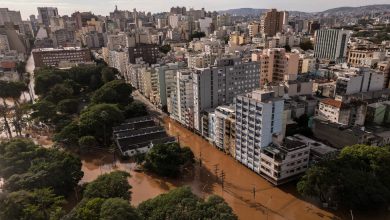Torrential Rain and Floods Wreak Havoc Across East Africa

Heavy rains and floods have killed scores of people and displaced hundreds of thousands of others across eastern Africa in recent weeks, governments and the United Nations said, underscoring the intensifying climatic hazards in a politically and economically tumultuous region.
At least 179 people have been killed in countries including Ethiopia, Kenya and Somalia, according to the U.N. and government agencies, and some regional authorities believe the figures are most likely higher.
The torrential rains, which have devastated other nations including Burundi, Sudan, South Sudan and Uganda, have affected more than three million people in a region that was already reeling from its worst drought in four decades.
Since 2020, the drought conditions, aggravated by climate change, have decimated crops and livestock and left millions of people hungry and malnourished, and hundreds of children dead.
The United Nations has attributed the heavier-than-usual rains to two climatic events: the El Niño phenomenon, which originates in the equatorial Pacific Ocean and whose conditions release additional heat into the atmosphere, and a similar phenomenon known as the Indian Ocean Dipole.
The floods have damaged homes, bridges and schools, according to aid agencies, who have warned of an uptick in disease outbreaks, including cholera and malaria.
In Somalia, where the floods have affected 1.7 million people, the government declared a state of emergency in October. The U.N. said the country was facing “once-in-a-century flooding.” Most of those affected live in the southern part of the country, where heavy rains have pushed the two main rivers to break banks and submerge homes and farms.
The floods have so far killed at least 96 people in the country, including children, according to Farhan Jimale, the government spokesman.
“We were asleep when the water poured into our home,” Faiza Ahmed Farah, a mother of five children in the southwestern town of Hudur in Somalia, said in a telephone interview. “The floods took everything. We were only able to rescue the children.”
With bridges down and road networks largely impassable, the authorities are worried that they might not be able to quickly rescue displaced people or deliver food assistance.
In Kenya, the heavy downpours have killed more than 60 people, according to the U.N. Thousands of people have been displaced in towns and cities across the west and the northeast, too, while entire neighborhoods were submerged in the coastal county of Mombasa this month, according to the Kenya Red Cross.
The rains have ravaged the Dadaab refugee complex in Kenya, home to some 300,000 refugees who are mostly from Somalia. In Hagadera, one of the camps in the complex, cases of diarrhea have doubled in just two weeks, the International Rescue Committee said in an emailed statement.
Thousands of people in another one of the Dadaab camps have had to leave their makeshift homes and move into schools, according to Doctors Without Borders. With limited supplies, aid agencies are worried about outbreaks of waterborne diseases along with malnutrition in the camp.
Similar devastation has unfolded in neighboring countries including Ethiopia, where the pummeling rain has submerged large portions of land in several regions underwater, according to the U.N.
Thousands of homes have flooded across Sudan in recent weeks, even as millions flee a seven-month civil war. The rising waters have displaced thousands more in parts of South Sudan, a landlocked nation already burdened by years of violence and malnutrition.
For now, governments are scrambling to find money to reach those in need, including in Kenya, where disputes over the allocation of funds for flood victims have touched off a nationwide debate. And the U.N. and other aid agencies have said that funding needed to tackle such growing humanitarian needs has been declining in parts of the region.
Hussein Mohamed contributed reporting from Mogadishu, Somalia.




